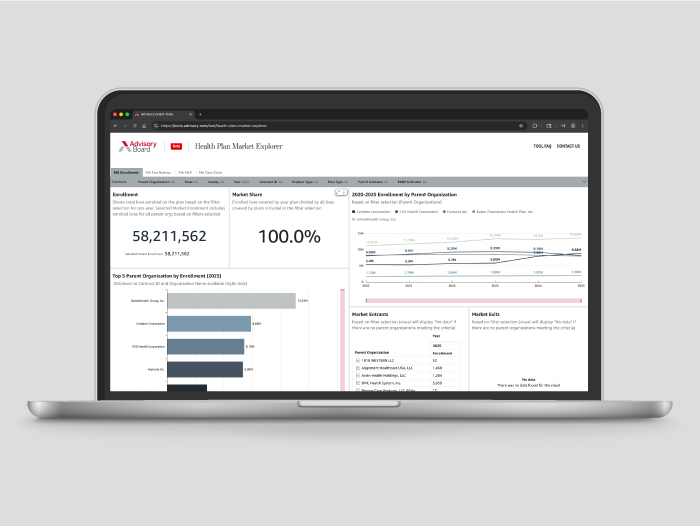Auto logout in seconds.
Continue LogoutA study recently published in JAMA found that adverse events increased in hospitals after they were acquired by private equity (PE) firms. And while the direct cause is unclear, many experts believe the challenges hospitals face after PE acquisitions may impact quality and patient safety. Advisory Board's Darby Sullivan and Allyson Paiewonsky offer four strategies that can help "fire-proof" your organization's quality efforts, regardless of ownership.
Study details and key findings
Last month, researchers analyzed Medicare Part A claims data to assess the impact of PE ownership on quality of care and patient outcomes.
In total, they analyzed data from more than 662,000 hospitalizations at 51 PE-acquired hospitals and over 4 million hospitalizations at 259 matched control hospitals from 2009 to 2019.
According to the study, PE acquisition was associated with a 25.4% increase in hospital-acquired conditions. This increase was largely driven by central line-associated bloodstream infections and falls: Three years after PE acquisition, the analysis found a 27.3% increase in falls and a 37.7% increase in central line-associated infections at acquired hospitals.
In addition, they found that Medicare beneficiaries at PE-owned hospitals were typically younger, less likely to be dually eligible for Medicare and Medicaid, and were transferred to other acute care hospitals more frequently, suggesting that the population admitted to PE-owned hospitals was lower risk.
Based on these findings, the researchers suggested that the PE-acquired hospitals were delivering "poorer quality of inpatient care" after the acquisitions.
"These findings heighten concerns about the implications of private equity on healthcare delivery," the researchers said.
"We were not surprised there was a signal," said Sneha Kannan, lead author of the study and physician at the division of pulmonary and critical care at Massachusetts General Hospital. "I will say we were surprised at how strong it was."
However, the study also found that the rate of patients who died during their stay at a PE-owned hospital decreased by almost 5%. According to the researchers, that decline could have been driven by the healthier patient population.
They noted that "the lack of improvement in 30-day mortality associated with private equity, especially given pre-acquisition trends that favored private equity hospitals, suggests that mortality effects are modest and at best mixed."
Reactions
According to researchers who reviewed the study, it doesn't provide a complete picture of PE's effect on hospitals, but it does surface key questions and concerns about the quality of care in PE-acquired hospitals.
"This is a big deal because it's the first piece of data that I think pretty strongly suggests that there is a quality problem when private equity takes over," said Ashish Jha, the dean of the Brown University School of Public Health.
Over the past 15 years, the rate of hospital-acquired conditions has decreased as hospitals have increasingly implemented safety measures to avoid them.
"They are preventable adverse events that everyone thinks shouldn't happen in hospitals," said David Blumenthal, the former president of the Commonwealth Fund, who reviewed the study.
According to Blumenthal, some PE owners are overly eager to pursue cost-cutting measures, which may lead to a decline in the quality of care. "It's about the style of investing," Blumenthal said. "It's about the aggressiveness and short-time-frame profits and returns on investment that are sought."
However, Blumenthal noted that PE acquisitions can be positive when they don't follow this strategy. "It brings capital. It brings innovation," he said.
While this study did not measure staffing levels, the researchers said the most likely explanation for the rise in adverse events following PE acquisition was decreased staffing levels, which have been recorded in other studies of PE acquisition.
"Reductions in staffing after acquisition could explain all of these findings," said study author Zirui Song.
Vivian Ho, a professor of economics at Rice University, who coauthored a paper that found reductions in staffing after PE acquisitions of hospitals, explained that it is difficult to be sure what drove the reductions. However, she said the results of this study caused enough concern that she is eager to see additional evidence.
"I'm willing to believe that it is because of the staffing issues," she said. "You just combine that with the anecdotal reports of what is going on in some of these hospitals, and it is a consistent story." (Phend, MedPage Today, 12/26/2023; Kannan et al., JAMA, 12/26/2023; Abelson/Sanger-Katz, New York Times, 12/26/2023; Muoio, Fierce Healthcare, 12/27/2023; Adams, MedCity News, 1/2)
4 ways to 'fire-proof' your quality goals
By Darby Sullivan and Allyson Paiewonsky
In today's healthcare landscape, provider organizations — PE-owned or otherwise — face numerous hurdles in achieving their quality and outcomes goals. And leaders often find themselves occupied by daily operational issues, which can divert their attention away from critical quality improvement initiatives.
As the JAMA study indicated, PE acquisitions can exacerbate quality challenges.
But there are steps provider organizations must take to ensure quality and patient safety are the same, regardless of ownership status. Here are four strategies that can help "fire-proof" your organization's quality efforts:
1. Hardwire quality responsibilities
During times of transition, it can be difficult to establish clear ownership of quality responsibilities. Following a PE acquisition, leaders should integrate quality goals throughout the entire organization.
By delegating quality responsibilities across the executive team and establishing clear ownership of quality goals across departments, provider organizations can foster a culture of ownership and accountability, inspiring a shared commitment to quality.
2. Move beyond one-off quality improvement campaigns
To ensure lasting change and continuous progress in quality and safety, organizations should shift away from one-off quality improvement campaigns. Instead, they should take a three-pronged approach.
- Integrate quality improvement efforts across the entire system: To avoid duplicating efforts, leaders should ensure that quality initiatives are not confined to individual facilities or units.
- Prioritize and pace quality initiatives: If too many initiatives are implemented simultaneously, clinicians may become overwhelmed. Leaders should pace the introduction of quality initiatives to ensure that adequate attention and resources are dedicated to each opportunity.
- Implement operational changes: To maintain momentum, it is crucial to go beyond raising awareness and instead implement structural and procedural changes that embed the desired improvements into workflows.
3. Prioritize change management
Many organizations struggle to translate care standards into daily practice. This can make it difficult to scale quality initiatives across multiple units and facilities.
When asked why they struggle to embed quality standards, leaders typically cite two barriers: Clinician resistance or limited bandwidth. Both barriers are symptoms of a greater problem: Care standards are often designed without workflow in mind.
Instead of solely focusing on creating the perfect care standard, leaders should consider the practical aspects of workflow integration. When workflow considerations are incorporated into the design of care standards, frontline caregivers find them more user-friendly, leading to increased utilization of the protocols.
4. Invest in data management capabilities
When organizations strengthen their data management capabilities, they empower clinicians to accurately assess and enhance healthcare quality. To better do this, organizations can:
- Alleviate the burden on clinicians by streamlining and optimizing their infrastructure for data collection and reporting.
- Clearly outline the relevance and necessity of these metrics in improving patient outcomes to help clinicians understand their importance.
- Seamlessly share patient data and care information across systems, which enables effective collaboration and coordination of care among providers.
Each of these steps represents a critical area that is often overlooked amid the chaos of daily operations. By addressing these challenges head-on, organizations can pave the way for a healthcare system that consistently meets its quality goals.
Don't miss out on the latest Advisory Board insights
Create your free account to access 1 resource, including the latest research and webinars.
Want access without creating an account?
You have 1 free members-only resource remaining this month.
1 free members-only resources remaining
1 free members-only resources remaining
You've reached your limit of free insights
Become a member to access all of Advisory Board's resources, events, and experts
Never miss out on the latest innovative health care content tailored to you.
Benefits include:
You've reached your limit of free insights
Become a member to access all of Advisory Board's resources, events, and experts
Never miss out on the latest innovative health care content tailored to you.
Benefits include:
This content is available through your Curated Research partnership with Advisory Board. Click on ‘view this resource’ to read the full piece
Email ask@advisory.com to learn more
Click on ‘Become a Member’ to learn about the benefits of a Full-Access partnership with Advisory Board
Never miss out on the latest innovative health care content tailored to you.
Benefits Include:
This is for members only. Learn more.
Click on ‘Become a Member’ to learn about the benefits of a Full-Access partnership with Advisory Board
Never miss out on the latest innovative health care content tailored to you.




